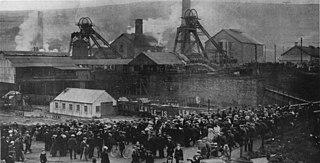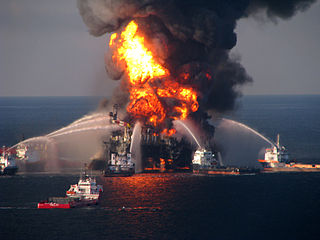Related Research Articles
A mining accident is an accident that occurs during the process of mining minerals or metals. Thousands of miners die from mining accidents each year, especially from underground coal mining, although accidents also occur in hard rock mining. Coal mining is considered much more hazardous than hard rock mining due to flat-lying rock strata, generally incompetent rock, the presence of methane gas, and coal dust. Most of the deaths these days occur in developing countries, and rural parts of developed countries where safety measures are not practiced as fully. A mining disaster is an incident where there are five or more fatalities.
New Waterford is an urban community in the Cape Breton Regional Municipality of Nova Scotia, Canada.

The Monongah mining disaster of Monongah, West Virginia occurred on December 6, 1907, and has been described as "the worst mining disaster in American history." 362 miners were killed. The explosion occurred in Fairmont Coal Company’s No. 6 and No. 8 mines, and was one of the contributing events leading to the creation of the United States Bureau of Mines.

The Sago Mine disaster was a coal mine explosion on January 2, 2006, at the Sago Mine in Sago, West Virginia, United States, near the Upshur County seat of Buckhannon. The blast and collapse trapped 13 miners for nearly two days; only one survived. It was the worst mining disaster in the United States since the Jim Walter Resources Mine disaster in Alabama on September 23, 2001, and the worst disaster in West Virginia since the 1968 Farmington Mine disaster. It was exceeded four years later by the Upper Big Branch Mine disaster, also a coal mine explosion in West Virginia, which killed 29 miners in April 2010.

The Farmington Mine disaster was an explosion that happened at approximately 5:30 a.m. on November 20, 1968, at the Consol No. 9 coal mine north of Farmington and Mannington, West Virginia, United States.

The Senghenydd colliery disaster, also known as the Senghenydd explosion, occurred at the Universal Colliery in Senghenydd, near Caerphilly, Glamorgan, Wales, on 14 October 1913. The explosion, which killed 439 miners and a rescuer, is the worst mining accident in the United Kingdom. Universal Colliery, on the South Wales Coalfield, extracted steam coal, which was much in demand. Some of the region's coal seams contained high quantities of firedamp, a highly explosive gas consisting of methane and hydrogen.

The Mount Mulligan mine disaster occurred on 19 September 1921 in Mount Mulligan, Far North Queensland, Australia. A series of explosions in the local coal mine, audible as much as 30 km away, rocked the close-knit township.

The Ulyanovskaya Mine disaster was caused by a methane explosion that occurred on March 19, 2007 in the Ulyanovskaya longwall coal mine in the Kemerovo Oblast. At least 108 people were reported to have been killed by the blast, which occurred at a depth of about 270 meters (885 feet) at 10:19 local time. The mine disaster was Russia's deadliest in more than a decade.

The health and environmental impact of the coal industry includes issues such as land use, waste management, water and air pollution, caused by the coal mining, processing and the use of its products. In addition to atmospheric pollution, coal burning produces hundreds of millions of tons of solid waste products annually, including fly ash, bottom ash, and flue-gas desulfurization sludge, that contain mercury, uranium, thorium, arsenic, and other heavy metals. Coal is the largest contributor to the human-made increase of carbon dioxide in Earth's atmosphere.

The Cross Mountain Mine disaster was a coal mine explosion that occurred on December 9, 1911, near the community of Briceville, Tennessee, in the southeastern United States. In spite of a well-organized rescue effort led by the newly created Bureau of Mines, 84 miners died in the disaster. The cause of the explosion was the ignition of dust and methane gas released by a roof fall. Miners would use open oil lamps to provide a light source down in the mines.

The Upper Big Branch Mine disaster occurred on April 5, 2010 roughly 1,000 feet (300 m) underground in Raleigh County, West Virginia at Massey Energy's Upper Big Branch coal mine located in Montcoal. Twenty-nine out of thirty-one miners at the site were killed. The coal dust explosion occurred at 3:27 pm. The accident was the worst in the United States since 1970, when 38 miners were killed at Finley Coal Company's No. 15 and 16 mines in Hyden, Kentucky. A state funded independent investigation later found Massey Energy directly responsible for the blast.
The Raspadskaya mine explosion was a mine explosion in the Raspadskaya mine, located near Mezhdurechensk in Kemerovo Oblast, Russia, which occurred on 8 May 2010. It was believed to have been caused by a buildup of methane. The initial explosion was followed by a second approximately four hours later which collapsed the mine's ventilation shaft and trapped several rescue workers. By 18 May 2010, 66 people were confirmed to have died with at least 99 others injured and as many as a further 24 unaccounted for.
The 2010 Zonguldak mine disaster occurred in Zonguldak Province, Turkey, on May 17, when 30 miners died in a firedamp explosion at the Karadon coal mine.

The Eccles mine disaster was an explosion of coal-seam methane that took place on April 28, 1914, in Eccles, West Virginia. The explosion took the lives of at least 180 men and boys.

Energy resources bring with them great social and economic promise, providing financial growth for communities and energy services for local economies. However, the infrastructure which delivers energy services can break down in an energy accident, sometimes causing considerable damage. Energy fatalities can occur, and with many systems deaths will happen often, even when the systems are working as intended.
The Benwood Mine Disaster was a coal mine explosion that occurred on Monday, April 28, 1924, at the Benwood Mine of the former Wheeling Steel Corporation steel mill located in the city of Benwood in Marshall County, West Virginia. The explosion claimed the lives of 119 coal miners. There were two survivors. It is the third worst coal mining disaster in the state of West Virginia after the Monongah Mine disaster of December 6, 1907 that claimed the lives of 361 miners and the Eccles Mine Disaster of April 28, 1914 that claimed the lives of 183 miners.
Scotts Run is a geographical division of the Cass District in Monongalia County, West Virginia, United States. Currently, it encompasses thirteen small, unincorporated communities. Located a few miles from Morgantown, this area's predominant industry in the early twentieth century was coal mining and production. Scotts Run became well known nationally during the years of the Great Depression, when photographers and the relief efforts of First Lady Eleanor Roosevelt publicized the impoverished conditions faced by the community. Since the decline in the coal industry in the area, Scotts Run's population has rapidly decreased. However, the current community is active in revitalization efforts to promote new businesses and heritage tourism.

In February 2016, a series of explosions caused the deaths of 36 people, including 31 miners and five rescue workers, at the Severnaya coal mine 10 kilometres north of the city of Vorkuta, Komi Republic, Russia. The explosions were believed to be caused by ignition of leaking methane gas. It is the second deadliest mining disaster of the 2010s behind the Soma mine disaster, and fourth deadliest of the 21st century thus far.
The Hlobane Coal Mine Disaster occurred at the Hlobane Colliery, Natal on 12 September 1983. The mine was the scene of another mining disaster 39 years earlier, an event that occurred on same date. A methane explosion in the mine caused burns and poisonous gas that killed 68 miners.
References
- 1 2 Rakes, Paul H. (22 October 2010). "Red Ash, Rush Run Explosions". e-WV: The West Virginia Encyclopedia. West Virginia Humanities Council. Retrieved 3 August 2016.
- ↑ Green, James (January 25, 2016). "A Day in the Life of a West Virginia Coal Miner. Cave-ins, explosions, and hard, brutal work". Literary Hub. From THE DEVIL HERE IN THESE HILLS (Atlantic Monthly Press). Retrieved 3 August 2016.